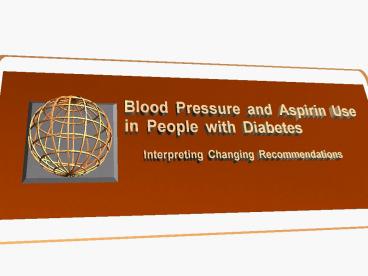Aspirin and Blood Pressure Recommendations in Diabetes
Title:
Aspirin and Blood Pressure Recommendations in Diabetes
Description:
Medical update of current recommendations for people with diabetes concerning aspirin use and blood pressure –
Number of Views:551
Title: Aspirin and Blood Pressure Recommendations in Diabetes
1
(No Transcript)
2
Dept of Family Medicine and Community Medicine
David Satin Kevin A Peterson
3
Changing Recommendations
- Optimal Diabetes Care (D5)
- A1c lt 7.0
- LDL lt 100
- Blood Pressure lt 130/80
- Tobacco Free
- Aspirin for all patients gt40
8.0 140/90
Daily Aspirin Use for Patients with
Ischemic Vascular/ Cardiovascular Disease
4
What is meant by Ischemic Vascular Disease?
- Ischemic Vascular Disease ICD-9 Codes
- (Code appears in the chart within the last
2 years as problem, visit code, or in written
documentation) - 410 410.92 Acute Myocardial Infarction (AMI)
- 411 411.89 Post Myocardial Infarction Syndrome
- 412 Old AMI
- 413 413.9 Angina Pectoris
- 414.0 414.07 Coronary Arthrosclerosis
- 414.2 Chronic Total Occlusion of Coronary Artery
- 414.8 Other Chronic Ischemic Heart Disease (IHD)
- 414.9 Chronic IHD
- 429.2 Cardiovascular (CV) disease, unspecified
- 433 433.91 Occlusion and stenosis of
pre-cerebral arteries - 434 434.91 Occlusion of cerebral arteries
- 440.1 Atherosclerosis of renal artery
- 440.2 440.29 Atherosclerosis of native arteries
of the extremities, unspecified - 440.4 Chronic Total Occlusion of Artery of the
Extremities - 444 444.9 Arterial embolism and thrombosis
- 445 - 445.8 Atheroembolism
5
What is the Evidence?
6
Nine Clinical Trials of Aspirin
- Antithrombotic Trialists (ATT) Collaboration
Aspirin - Combined meta-analysis demonstrates that ASA
reduces cardiovascular morbidity and mortality in
high risk patients with MI or stroke - Japanese Primary Prevention of Athersclerosis
(JPAD)1 - Low dose ASA primary prevention of CV event
- Randomized, Open label
- 2539 Japanese type 2 patients
- Prevention of Progression of Arterial Disease and
Diabetes (POPADAD)2 - 2x2 ASA/antioxidant versus placebo
- CV events in patients with diabetes and PAD
- Randomized double blind
- 1276 type 1 or 2 diabetes patients
1 Ogawa H, Nakayama M, et al, JAMA 3002134,
2008 2 Belch J, MacCush A, Campbell I, et al,
BMJ, 337a1840, 2008
7
Current Aspirin Recommendations
- ADA and AHA in 2007 recommended ASA in everyone
with diabetes over 40. In June, 2010 new
recommendations - Low dose ASA for adults with diabetes with 10 yr
risk of CVD over 10. This includes most men over
50 and women over 60 with one additional major
risk factor (smoking, HTN, dyslipidemia, FH,
albuminuria) - Recommends against ASA for people under 5 risk
over ten years. - Consider ASA for people at intermediate risk of
5-10 over ten years. - FDA has not approved ASA for primary prevention
of CV disease - USPSTF encourage use of ASA in men age 45-79, and
women 55-79 (Evidence A) if risk outweighs
benefit, and against ASA at younger ages
(Evidence D)
Baigent C, Blackwell L, Collins R, Emberson J,
etc, Lancet, 3731849, 2009
8
USPSTF Risk Calculations
USPSTF recommends individual determination of
risk. Recommends low dose ASA if the estimated
benefit outweighs the potential harm from GI
bleed or hemorrhagic stroke.
http//www.uspreventiveservicestaskforce.org/uspst
f09/aspirincvd/aspcvdrsf2.htm
9
Current Blood Pressure Recommendations
- Joint National Committee on Prevention,
Detection, Evaluation, and Treatment of High
Blood Pressure, 2003 - UKPDS
- Blood pressure of lt130/80 not based on evidence
from randomized controlled trials - ACCORD
10
Published online March 14, 2010
11
Accord BP Study
- The ACCORD BP trial evaluated the effect of
targeting a SBP goal of 120 mm Hg, compared to a
goal of 140 mm Hg, in patients with type 2
diabetes at increased cardiovascular risk.
12
Systolic Pressures (mean 95 CI)
Mean Meds Intensive 3.2
3.4 3.5
3.4 Standard
1.9 2.1
2.2 2.3
Average after 1st year 133.5 Standard vs. 119.3
Intensive, Delta 14.2
13
Medications Prescribed (12 Month Visit)
14
Primary Outcome Nonfatal MI, Nonfatal Stroke or
CVD Death
HR 0.88 95 CI (0.73-1.06)
No significant difference in the composite
measure
15
Adverse Events
Intensive N () Standard N () P
Serious AE 77 (3.3) 30 (1.3) lt0.0001
Hypotension 17 (0.7) 1 (0.04) lt0.0001
Syncope 12 (0.5) 5 (0.2) 0.10
Bradycardia or Arrhythmia 12 (0.5) 3 (0.1) 0.02
Hyperkalemia 9 (0.4) 1 (0.04) 0.01
Renal Failure 5 (0.2) 1 (0.04) 0.12
eGFR ever lt30 mL/min/1.73m2 99 (4.2) 52 (2.2) lt0.001
Any Dialysis or ESRD 59 (2.5) 58 (2.4) 0.93
Dizziness on Standing 217 (44) 188 (40) 0.36
Symptom experienced over past 30 days from
HRQL sample of N969 participants assessed at 12,
36, and 48 months post-randomization
16
Primary Secondary Outcomes
Intensive Events (/yr) Standard Events (/yr) HR (95 CI) P
Primary 208 (1.87) 237 (2.09) 0.88 (0.73-1.06) 0.20
Total Mortality 150 (1.28) 144 (1.19) 1.07 (0.85-1.35) 0.55
Cardiovascular Deaths 60 (0.52) 58 (0.49) 1.06 (0.74-1.52) 0.74
Nonfatal MI 126 (1.13) 146 (1.28) 0.87 (0.68-1.10) 0.25
Nonfatal Stroke 34 (0.30) 55 (0.47) 0.63 (0.41-0.96) 0.03
Total Stroke 36 (0.32) 62 (0.53) 0.59 (0.39-0.89) 0.01
Also examined Fatal/Nonfatal HF (HR0.94,
p0.67), a composite of fatal coronary events,
nonfatal MI and unstable angina (HR0.94, p0.50)
and a composite of the primary outcome,
revascularization and unstable angina
(HR0.95, p0.40)
17
Nonfatal Stroke
Total Stroke
HR 0.63 95 CI (0.41-0.96)
HR 0.59 95 CI (0.39-0.89)
18
Risk versus benefit
Frequency of event
Cardiovascular Risk
19
Summary
- Clinical Measures ? Clinical Guidelines
- A1c lt8, SBPlt140, LDL lt 100, ASA, no tobacco
- not always right for the individual
- Meeting targets diminishes the impact of other
factors - Lower is better -
- but struggling for lower numbers comes with an
increased risk of problems - The target depends on the patient
20
(No Transcript)































